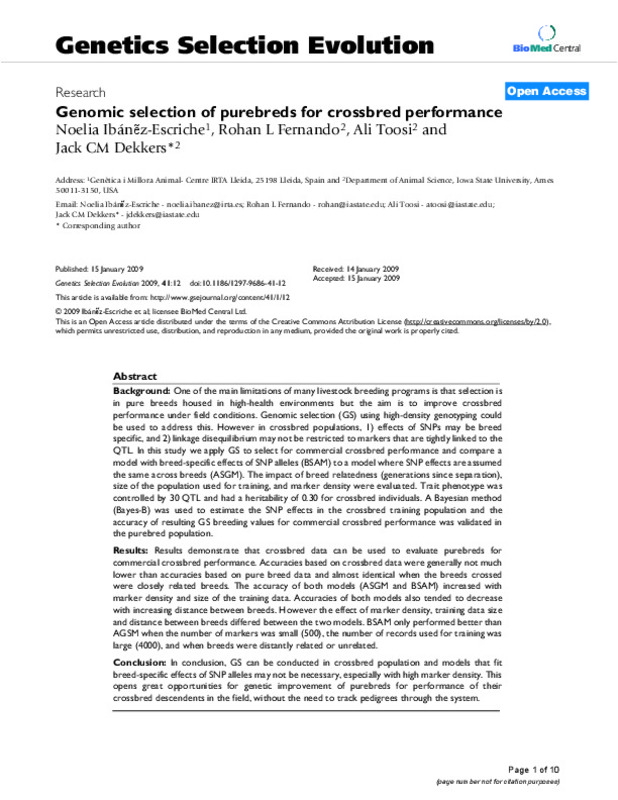JavaScript is disabled for your browser. Some features of this site may not work without it.
Buscar en RiuNet
Listar
Mi cuenta
Estadísticas
Ayuda RiuNet
Admin. UPV
Genomic selection of purebreds for crossbred performance
Mostrar el registro sencillo del ítem
Ficheros en el ítem
| dc.contributor.author | Ibáñez-Escriche, Noelia
|
es_ES |
| dc.contributor.author | Fernando, R. L.
|
es_ES |
| dc.contributor.author | Tossi, A.
|
es_ES |
| dc.contributor.author | Dekkers, Jack C. M.
|
es_ES |
| dc.date.accessioned | 2020-09-24T12:28:48Z | |
| dc.date.available | 2020-09-24T12:28:48Z | |
| dc.date.issued | 2009-01-15 | es_ES |
| dc.identifier.issn | 0999-193X | es_ES |
| dc.identifier.uri | http://hdl.handle.net/10251/150633 | |
| dc.description.abstract | [EN] Background: One of the main limitations of many livestock breeding programs is that selection is in pure breeds housed in high-health environments but the aim is to improve crossbred performance under field conditions. Genomic selection (GS) using high-density genotyping could be used to address this. However in crossbred populations, 1) effects of SNPs may be breed specific, and 2) linkage disequilibrium may not be restricted to markers that are tightly linked to the QTL. In this study we apply GS to select for commercial crossbred performance and compare a model with breed-specific effects of SNP alleles (BSAM) to a model where SNP effects are assumed the same across breeds (ASGM). The impact of breed relatedness (generations since separation), size of the population used for training, and marker density were evaluated. Trait phenotype was controlled by 30 QTL and had a heritability of 0.30 for crossbred individuals. A Bayesian method (Bayes-B) was used to estimate the SNP effects in the crossbred training population and the accuracy of resulting GS breeding values for commercial crossbred performance was validated in the purebred population. Results: Results demonstrate that crossbred data can be used to evaluate purebreds for commercial crossbred performance. Accuracies based on crossbred data were generally not much lower than accuracies based on pure breed data and almost identical when the breeds crossed were closely related breeds. The accuracy of both models (ASGM and BSAM) increased with marker density and size of the training data. Accuracies of both models also tended to decrease with increasing distance between breeds. However the effect of marker density, training data size and distance between breeds differed between the two models. BSAM only performed better than AGSM when the number of markers was small (500), the number of records used for training was large (4000), and when breeds were distantly related or unrelated. Conclusion: In conclusion, GS can be conducted in crossbred population and models that fit breed-specific effects of SNP alleles may not be necessary, especially with high marker density. This opens great opportunities for genetic improvement of purebreds for performance of their crossbred descendents in the field, without the need to track pedigrees through the system. | es_ES |
| dc.description.sponsorship | Financial support from Spain's Ministerio de Educacion y Ciencia (Programa movilidad Jose Castillejo) for NEI, and from Newsham Choice Genetics for AT is gratefully acknowledge. RLF and JCMD are supported by the United States Department of Agriculture, National Research Initiative grant USDA-NRI-2007-35205-17862 and by Hatch and State of Iowa funds through the Iowa Agricultural and Home Economics Experiment Station, Ames, IA. | es_ES |
| dc.language | Inglés | es_ES |
| dc.publisher | Springer (Biomed Central Ltd.) | es_ES |
| dc.relation.ispartof | Genetics Selection Evolution | es_ES |
| dc.rights | Reconocimiento (by) | es_ES |
| dc.subject.classification | PRODUCCION ANIMAL | es_ES |
| dc.title | Genomic selection of purebreds for crossbred performance | es_ES |
| dc.type | Artículo | es_ES |
| dc.identifier.doi | 10.1186/1297-9686-41-12 | es_ES |
| dc.relation.projectID | info:eu-repo/grantAgreement/USDA ARS//USDA-NRI-2007-35205-17862/ | es_ES |
| dc.rights.accessRights | Abierto | es_ES |
| dc.contributor.affiliation | Universitat Politècnica de València. Departamento de Ciencia Animal - Departament de Ciència Animal | es_ES |
| dc.description.bibliographicCitation | Ibáñez-Escriche, N.; Fernando, RL.; Tossi, A.; Dekkers, JCM. (2009). Genomic selection of purebreds for crossbred performance. Genetics Selection Evolution. 41(12). https://doi.org/10.1186/1297-9686-41-12 | es_ES |
| dc.description.accrualMethod | S | es_ES |
| dc.relation.publisherversion | https://doi.org/10.1186/1297-9686-41-12 | es_ES |
| dc.type.version | info:eu-repo/semantics/publishedVersion | es_ES |
| dc.description.volume | 41 | es_ES |
| dc.description.issue | 12 | es_ES |
| dc.identifier.pmid | 19284703 | es_ES |
| dc.relation.pasarela | S\392950 | es_ES |
| dc.contributor.funder | Ministerio de Educación y Ciencia | es_ES |
| dc.contributor.funder | Iowa Agriculture and Home Economics Experiment Station | es_ES |
| dc.contributor.funder | United States Department of Agriculture, Agricultural Research Service | es_ES |








